[English] 日本語
 Yorodumi
Yorodumi- PDB-8p75: Cryo-EM structure of CAK in complex with inhibitor ICEC0880 (ring... -
+ Open data
Open data
- Basic information
Basic information
| Entry | Database: PDB / ID: 8p75 | ||||||
|---|---|---|---|---|---|---|---|
| Title | Cryo-EM structure of CAK in complex with inhibitor ICEC0880 (ring-down conformation) | ||||||
 Components Components |
| ||||||
 Keywords Keywords |  TRANSFERASE / TRANSFERASE /  Kinase / Inhibitor / Kinase / Inhibitor /  Transcription / Transcription /  Cell Cycle Cell Cycle | ||||||
| Function / homology |  Function and homology information Function and homology informationnegative regulation of DNA helicase activity /  ventricular system development / cyclin-dependent protein kinase activating kinase holoenzyme complex / snRNA transcription by RNA polymerase II / CAK-ERCC2 complex / transcription factor TFIIK complex / adult heart development / transcription factor TFIIH holo complex / transcription factor TFIIH core complex / cyclin-dependent protein serine/threonine kinase activator activity ...negative regulation of DNA helicase activity / ventricular system development / cyclin-dependent protein kinase activating kinase holoenzyme complex / snRNA transcription by RNA polymerase II / CAK-ERCC2 complex / transcription factor TFIIK complex / adult heart development / transcription factor TFIIH holo complex / transcription factor TFIIH core complex / cyclin-dependent protein serine/threonine kinase activator activity ...negative regulation of DNA helicase activity /  ventricular system development / cyclin-dependent protein kinase activating kinase holoenzyme complex / snRNA transcription by RNA polymerase II / CAK-ERCC2 complex / transcription factor TFIIK complex / adult heart development / transcription factor TFIIH holo complex / transcription factor TFIIH core complex / cyclin-dependent protein serine/threonine kinase activator activity / [RNA-polymerase]-subunit kinase / RNA Polymerase I Transcription Termination / cyclin-dependent protein serine/threonine kinase regulator activity / RNA Pol II CTD phosphorylation and interaction with CE during HIV infection / RNA Pol II CTD phosphorylation and interaction with CE / Formation of the Early Elongation Complex / Formation of the HIV-1 Early Elongation Complex / mRNA Capping / HIV Transcription Initiation / RNA Polymerase II HIV Promoter Escape / Transcription of the HIV genome / RNA Polymerase II Promoter Escape / RNA Polymerase II Transcription Pre-Initiation And Promoter Opening / RNA Polymerase II Transcription Initiation / RNA Polymerase II Transcription Initiation And Promoter Clearance / regulation of cyclin-dependent protein serine/threonine kinase activity / regulation of G1/S transition of mitotic cell cycle / RNA Polymerase I Transcription Initiation / RNA polymerase II transcribes snRNA genes / Tat-mediated elongation of the HIV-1 transcript / Formation of HIV-1 elongation complex containing HIV-1 Tat / ATP-dependent activity, acting on DNA / ventricular system development / cyclin-dependent protein kinase activating kinase holoenzyme complex / snRNA transcription by RNA polymerase II / CAK-ERCC2 complex / transcription factor TFIIK complex / adult heart development / transcription factor TFIIH holo complex / transcription factor TFIIH core complex / cyclin-dependent protein serine/threonine kinase activator activity / [RNA-polymerase]-subunit kinase / RNA Polymerase I Transcription Termination / cyclin-dependent protein serine/threonine kinase regulator activity / RNA Pol II CTD phosphorylation and interaction with CE during HIV infection / RNA Pol II CTD phosphorylation and interaction with CE / Formation of the Early Elongation Complex / Formation of the HIV-1 Early Elongation Complex / mRNA Capping / HIV Transcription Initiation / RNA Polymerase II HIV Promoter Escape / Transcription of the HIV genome / RNA Polymerase II Promoter Escape / RNA Polymerase II Transcription Pre-Initiation And Promoter Opening / RNA Polymerase II Transcription Initiation / RNA Polymerase II Transcription Initiation And Promoter Clearance / regulation of cyclin-dependent protein serine/threonine kinase activity / regulation of G1/S transition of mitotic cell cycle / RNA Polymerase I Transcription Initiation / RNA polymerase II transcribes snRNA genes / Tat-mediated elongation of the HIV-1 transcript / Formation of HIV-1 elongation complex containing HIV-1 Tat / ATP-dependent activity, acting on DNA /  cyclin-dependent kinase / Formation of HIV elongation complex in the absence of HIV Tat / cyclin-dependent protein serine/threonine kinase activity / Cyclin E associated events during G1/S transition / RNA Polymerase II Transcription Elongation / Cyclin A/B1/B2 associated events during G2/M transition / Formation of RNA Pol II elongation complex / Cyclin A:Cdk2-associated events at S phase entry / RNA Polymerase II Pre-transcription Events / RNA polymerase II CTD heptapeptide repeat kinase activity / male germ cell nucleus / cyclin-dependent kinase / Formation of HIV elongation complex in the absence of HIV Tat / cyclin-dependent protein serine/threonine kinase activity / Cyclin E associated events during G1/S transition / RNA Polymerase II Transcription Elongation / Cyclin A/B1/B2 associated events during G2/M transition / Formation of RNA Pol II elongation complex / Cyclin A:Cdk2-associated events at S phase entry / RNA Polymerase II Pre-transcription Events / RNA polymerase II CTD heptapeptide repeat kinase activity / male germ cell nucleus /  transcription initiation at RNA polymerase II promoter / nucleotide-excision repair / RNA Polymerase I Promoter Escape / TP53 Regulates Transcription of DNA Repair Genes / positive regulation of smooth muscle cell proliferation / G1/S transition of mitotic cell cycle / NoRC negatively regulates rRNA expression / Transcription-Coupled Nucleotide Excision Repair (TC-NER) / Formation of TC-NER Pre-Incision Complex / transcription initiation at RNA polymerase II promoter / nucleotide-excision repair / RNA Polymerase I Promoter Escape / TP53 Regulates Transcription of DNA Repair Genes / positive regulation of smooth muscle cell proliferation / G1/S transition of mitotic cell cycle / NoRC negatively regulates rRNA expression / Transcription-Coupled Nucleotide Excision Repair (TC-NER) / Formation of TC-NER Pre-Incision Complex /  fibrillar center / Formation of Incision Complex in GG-NER / Dual incision in TC-NER / response to calcium ion / Gap-filling DNA repair synthesis and ligation in TC-NER / Cyclin D associated events in G1 / RUNX1 regulates transcription of genes involved in differentiation of HSCs / protein-containing complex assembly / transcription by RNA polymerase II / protein stabilization / fibrillar center / Formation of Incision Complex in GG-NER / Dual incision in TC-NER / response to calcium ion / Gap-filling DNA repair synthesis and ligation in TC-NER / Cyclin D associated events in G1 / RUNX1 regulates transcription of genes involved in differentiation of HSCs / protein-containing complex assembly / transcription by RNA polymerase II / protein stabilization /  regulation of cell cycle / regulation of cell cycle /  protein kinase activity / protein kinase activity /  cell cycle / cell cycle /  cell division / cell division /  phosphorylation / phosphorylation /  DNA repair / protein serine kinase activity / protein serine/threonine kinase activity / regulation of transcription by RNA polymerase II / negative regulation of apoptotic process / perinuclear region of cytoplasm / positive regulation of transcription by RNA polymerase II / zinc ion binding / DNA repair / protein serine kinase activity / protein serine/threonine kinase activity / regulation of transcription by RNA polymerase II / negative regulation of apoptotic process / perinuclear region of cytoplasm / positive regulation of transcription by RNA polymerase II / zinc ion binding /  nucleoplasm / nucleoplasm /  ATP binding / ATP binding /  nucleus / nucleus /  plasma membrane / plasma membrane /  cytosol / cytosol /  cytoplasm cytoplasmSimilarity search - Function | ||||||
| Biological species |   Homo sapiens (human) Homo sapiens (human) | ||||||
| Method |  ELECTRON MICROSCOPY / ELECTRON MICROSCOPY /  single particle reconstruction / single particle reconstruction /  cryo EM / Resolution: 2 Å cryo EM / Resolution: 2 Å | ||||||
 Authors Authors | Cushing, V.I. / Koh, A.F. / Feng, J. / Jurgaityte, K. / Bahl, A.K. / Ali, S. / Kotecha, A. / Greber, B.J. | ||||||
| Funding support |  United Kingdom, 1items United Kingdom, 1items
| ||||||
 Citation Citation |  Journal: Nat Commun / Year: 2024 Journal: Nat Commun / Year: 2024Title: High-resolution cryo-EM of the human CDK-activating kinase for structure-based drug design. Authors: Victoria I Cushing / Adrian F Koh / Junjie Feng / Kaste Jurgaityte / Alexander Bondke / Sebastian H B Kroll / Marion Barbazanges / Bodo Scheiper / Ash K Bahl / Anthony G M Barrett / Simak ...Authors: Victoria I Cushing / Adrian F Koh / Junjie Feng / Kaste Jurgaityte / Alexander Bondke / Sebastian H B Kroll / Marion Barbazanges / Bodo Scheiper / Ash K Bahl / Anthony G M Barrett / Simak Ali / Abhay Kotecha / Basil J Greber /     Abstract: Rational design of next-generation therapeutics can be facilitated by high-resolution structures of drug targets bound to small-molecule inhibitors. However, application of structure-based methods to ...Rational design of next-generation therapeutics can be facilitated by high-resolution structures of drug targets bound to small-molecule inhibitors. However, application of structure-based methods to macromolecules refractory to crystallization has been hampered by the often-limiting resolution and throughput of cryogenic electron microscopy (cryo-EM). Here, we use high-resolution cryo-EM to determine structures of the CDK-activating kinase, a master regulator of cell growth and division, in its free and nucleotide-bound states and in complex with 15 inhibitors at up to 1.8 Å resolution. Our structures provide detailed insight into inhibitor interactions and networks of water molecules in the active site of cyclin-dependent kinase 7 and provide insights into the mechanisms contributing to inhibitor selectivity, thereby providing the basis for rational design of next-generation therapeutics. These results establish a methodological framework for the use of high-resolution cryo-EM in structure-based drug design. | ||||||
| History |
|
- Structure visualization
Structure visualization
| Structure viewer | Molecule:  Molmil Molmil Jmol/JSmol Jmol/JSmol |
|---|
- Downloads & links
Downloads & links
- Download
Download
| PDBx/mmCIF format |  8p75.cif.gz 8p75.cif.gz | 144.3 KB | Display |  PDBx/mmCIF format PDBx/mmCIF format |
|---|---|---|---|---|
| PDB format |  pdb8p75.ent.gz pdb8p75.ent.gz | 106.6 KB | Display |  PDB format PDB format |
| PDBx/mmJSON format |  8p75.json.gz 8p75.json.gz | Tree view |  PDBx/mmJSON format PDBx/mmJSON format | |
| Others |  Other downloads Other downloads |
-Validation report
| Arichive directory |  https://data.pdbj.org/pub/pdb/validation_reports/p7/8p75 https://data.pdbj.org/pub/pdb/validation_reports/p7/8p75 ftp://data.pdbj.org/pub/pdb/validation_reports/p7/8p75 ftp://data.pdbj.org/pub/pdb/validation_reports/p7/8p75 | HTTPS FTP |
|---|
-Related structure data
| Related structure data |  17518MC  8ormC  8p6vC 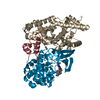 8p6wC  8p6xC  8p6yC 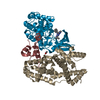 8p6zC 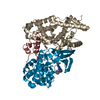 8p70C 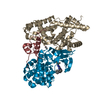 8p71C 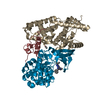 8p72C 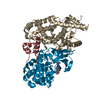 8p73C 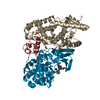 8p74C 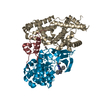 8p76C 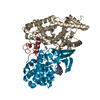 8p77C 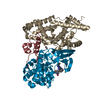 8p78C  8p79C 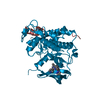 8p7lC 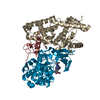 8plzC C: citing same article ( M: map data used to model this data |
|---|---|
| Similar structure data | Similarity search - Function & homology  F&H Search F&H Search |
- Links
Links
- Assembly
Assembly
| Deposited unit | 
|
|---|---|
| 1 |
|
- Components
Components
| #1: Protein | Mass: 10234.531 Da / Num. of mol.: 1 Source method: isolated from a genetically manipulated source Source: (gene. exp.)   Homo sapiens (human) / Gene: MNAT1, CAP35, MAT1, RNF66 / Production host: Homo sapiens (human) / Gene: MNAT1, CAP35, MAT1, RNF66 / Production host:   Trichoplusia ni (cabbage looper) / References: UniProt: P51948 Trichoplusia ni (cabbage looper) / References: UniProt: P51948 |
|---|---|
| #2: Protein | Mass: 37721.508 Da / Num. of mol.: 1 Source method: isolated from a genetically manipulated source Source: (gene. exp.)   Homo sapiens (human) / Gene: CCNH / Production host: Homo sapiens (human) / Gene: CCNH / Production host:   Trichoplusia ni (cabbage looper) / References: UniProt: P51946 Trichoplusia ni (cabbage looper) / References: UniProt: P51946 |
| #3: Protein |  / 39 kDa protein kinase / p39 Mo15 / CDK-activating kinase 1 / Cell division protein kinase 7 / ...39 kDa protein kinase / p39 Mo15 / CDK-activating kinase 1 / Cell division protein kinase 7 / Serine/threonine-protein kinase 1 / TFIIH basal transcription factor complex kinase subunit / 39 kDa protein kinase / p39 Mo15 / CDK-activating kinase 1 / Cell division protein kinase 7 / ...39 kDa protein kinase / p39 Mo15 / CDK-activating kinase 1 / Cell division protein kinase 7 / Serine/threonine-protein kinase 1 / TFIIH basal transcription factor complex kinase subunitMass: 39362.598 Da / Num. of mol.: 1 Source method: isolated from a genetically manipulated source Source: (gene. exp.)   Homo sapiens (human) / Gene: CDK7, CAK, CAK1, CDKN7, MO15, STK1 / Production host: Homo sapiens (human) / Gene: CDK7, CAK, CAK1, CDKN7, MO15, STK1 / Production host:   Trichoplusia ni (cabbage looper) Trichoplusia ni (cabbage looper)References: UniProt: P50613,  cyclin-dependent kinase, [RNA-polymerase]-subunit kinase cyclin-dependent kinase, [RNA-polymerase]-subunit kinase |
| #4: Chemical | ChemComp-X3Z / ( Mass: 464.356 Da / Num. of mol.: 1 / Source method: obtained synthetically / Formula: C20H26BrN5O3 |
| #5: Water | ChemComp-HOH /  Water Water |
| Has ligand of interest | Y |
-Experimental details
-Experiment
| Experiment | Method:  ELECTRON MICROSCOPY ELECTRON MICROSCOPY |
|---|---|
| EM experiment | Aggregation state: PARTICLE / 3D reconstruction method:  single particle reconstruction single particle reconstruction |
- Sample preparation
Sample preparation
| Component | Name: CDK-activating kinase / Type: COMPLEX / Type: COMPLEXDetails: CAK in complex with non-covalent inhibitor ICEC0880 (ring-down conformation) Entity ID: #1-#3 / Source: RECOMBINANT | |||||||||||||||||||||||||
|---|---|---|---|---|---|---|---|---|---|---|---|---|---|---|---|---|---|---|---|---|---|---|---|---|---|---|
| Molecular weight | Value: 0.085 MDa / Experimental value: NO | |||||||||||||||||||||||||
| Source (natural) | Organism:   Homo sapiens (human) Homo sapiens (human) | |||||||||||||||||||||||||
| Source (recombinant) | Organism:   Trichoplusia ni (cabbage looper) Trichoplusia ni (cabbage looper) | |||||||||||||||||||||||||
| Buffer solution | pH: 7.9 | |||||||||||||||||||||||||
| Buffer component |
| |||||||||||||||||||||||||
| Specimen | Conc.: 0.4 mg/ml / Embedding applied: NO / Shadowing applied: NO / Staining applied : NO / Vitrification applied : NO / Vitrification applied : YES : YES | |||||||||||||||||||||||||
| Specimen support | Grid material: GOLD / Grid mesh size: 300 divisions/in. / Grid type: Quantifoil R1.2/1.3 | |||||||||||||||||||||||||
Vitrification | Instrument: FEI VITROBOT MARK IV / Cryogen name: ETHANE / Humidity: 100 % / Chamber temperature: 278 K |
- Electron microscopy imaging
Electron microscopy imaging
| Experimental equipment |  Model: Titan Krios / Image courtesy: FEI Company |
|---|---|
| Microscopy | Model: TFS KRIOS |
| Electron gun | Electron source : :  FIELD EMISSION GUN / Accelerating voltage: 300 kV / Illumination mode: FLOOD BEAM FIELD EMISSION GUN / Accelerating voltage: 300 kV / Illumination mode: FLOOD BEAM |
| Electron lens | Mode: BRIGHT FIELD Bright-field microscopy / Calibrated magnification: 245614 X / Nominal defocus max: 1700 nm / Nominal defocus min: 400 nm / Cs Bright-field microscopy / Calibrated magnification: 245614 X / Nominal defocus max: 1700 nm / Nominal defocus min: 400 nm / Cs : 2.7 mm / C2 aperture diameter: 50 µm / Alignment procedure: COMA FREE : 2.7 mm / C2 aperture diameter: 50 µm / Alignment procedure: COMA FREE |
| Specimen holder | Cryogen: NITROGEN / Specimen holder model: FEI TITAN KRIOS AUTOGRID HOLDER |
| Image recording | Electron dose: 70 e/Å2 / Film or detector model: TFS FALCON 4i (4k x 4k) / Num. of grids imaged: 1 / Num. of real images: 5426 |
| EM imaging optics | Energyfilter name : TFS Selectris X / Energyfilter slit width: 10 eV : TFS Selectris X / Energyfilter slit width: 10 eV |
- Processing
Processing
| EM software |
| ||||||||||||||||||||||||||||||||||||||||||||
|---|---|---|---|---|---|---|---|---|---|---|---|---|---|---|---|---|---|---|---|---|---|---|---|---|---|---|---|---|---|---|---|---|---|---|---|---|---|---|---|---|---|---|---|---|---|
CTF correction | Type: PHASE FLIPPING AND AMPLITUDE CORRECTION | ||||||||||||||||||||||||||||||||||||||||||||
3D reconstruction | Resolution: 2 Å / Resolution method: FSC 0.143 CUT-OFF / Num. of particles: 112809 / Algorithm: FOURIER SPACE / Symmetry type: POINT | ||||||||||||||||||||||||||||||||||||||||||||
| Atomic model building | Protocol: RIGID BODY FIT / Space: REAL | ||||||||||||||||||||||||||||||||||||||||||||
| Atomic model building | PDB-ID: 8ORM Accession code: 8ORM / Source name: PDB / Type: experimental model | ||||||||||||||||||||||||||||||||||||||||||||
| Refine LS restraints |
|
 Movie
Movie Controller
Controller






























































 PDBj
PDBj















